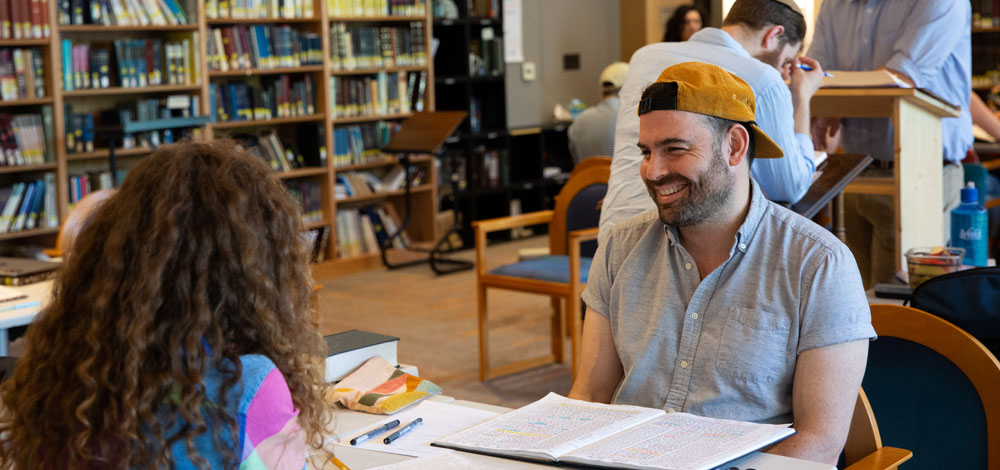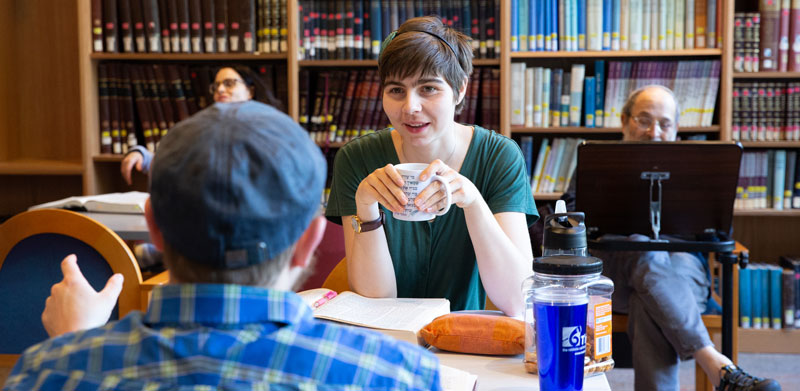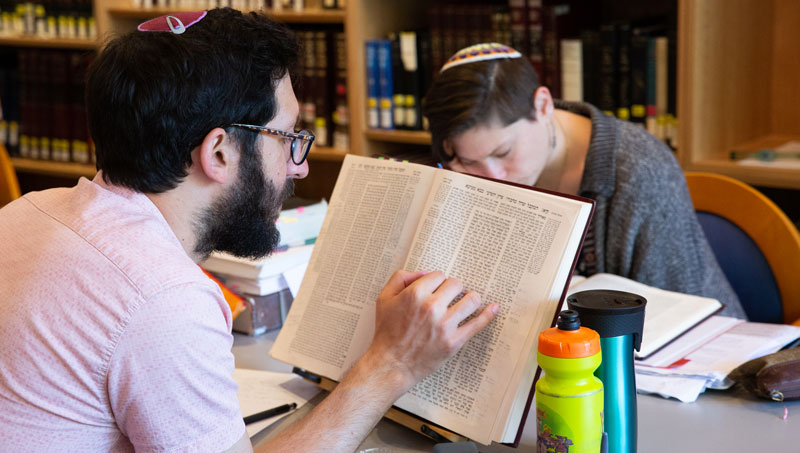Community Blog Hebrew College Beit Midrash: Relationships with the Texts and Each Other Are at the Heart of Rabbinic Education

For Heather Renetzky, rabbinical student in Shanna Hey, Hebrew College’s Mascott Beit Midrash is more than a place of learning. It is the of heart of the Rabbinical School , a place where relationships with Torah and Talmud, fellow students, and Jewish spirituality flourish. “There is a beautiful text in Brachot that talks about how when people are studying together, the Shekinah, the presence of God is with them,” Renetzky said. “You learn about each other’s lives through studying together, and by making study together an essential part of the rabbinical program, we are bringing the texts to life and our lives to the texts.”
A Beit Midrash (literally a “house of learning”) is a traditional institution of rabbinic learning, a place where sacred Jewish texts are studied in community. Central to the experience of Beit Midrash are chevruta (“fellowship” or “pairs”), a time-honored rabbinic approach to Talmudic study in which a small group of students analyze, discuss, and debate a shared text. Both institutions are at the heart-center of the Hebrew College community, the core of rabbinic education for all Hebrew College students, from the initial Mekorot (prepartory year) and Shanah Aleph years of rabbinical study, through ordination.

“We see the Beit Midrash as a gathering place for forming deep connections fundamental to the spiritual work of Talmud Torah: with your ancestors, who speak through the text; with your chevruta, your partner in the learning project; with the broader learning community whose words and insights will buzz in the air around you; and with the Divine,” Rabbi Shani Rosenbaum, co-director of the Beit Midrash said.
When the Rabbinical School was founded in 2003, one of its central commitments was training rabbis who have both a deep knowledge of Judaism and profound openness to what Judaism could look like. According to Rabbi Daniel Klein (below), dean of students, the Beit Midrash embodies these commitments.

“We aren’t a movement-affiliated school—we don’t have a version of Judaism that we espouse as the way to practice. What we have is a real openness to what Jewish life and practice can look like. Beit Midrash becomes a wonderful place to be in conversation about that and support each other in that,” Klein said.
In the Beit Midrash and through chevruta relationships, students encounter texts in their original languages of Hebrew and Aramaic, sharing the challenges together. Different backgrounds, different ways of orienting around Jewish practice, and different interpretations of the texts are celebrated for the richness and strength they bring toward the formation of future rabbis who will lead in diverse communities.
“Seeing disagreement as progress is important. Once we realize where we disagree, it helps us strengthen our own identities, and we are also changed through the process of being in dialogue,” said Rabbi Tyler Dratch `21, assistant rabbi at Beth Am Synagogue in Baltimore, MD.
In chevruta, students will help their partners understand and corroborate the best version of their argument by asking clarifying questions and working together to understand where each person is in the debate–seeking to understand rather than convince.
“Really spending the time to make sure we understand what each of us is saying,” Dratch said. “I think this is an important skill in learning how to dialogue with anyone and an important skill in trying to seek truth.”

Dratch originally became friends with Renetzky (above, right) through the Conservative Movement’s United Synagogue Youth (USY) while they were teenagers, when the two had gone with the youth group’s trip to Israel. Their friendship developed into a chevruta partnership when Renetzky and Dratch found themselves again in Israel years later, when Renetzky was in her first Mekorot year of Hebrew College education and Dratch, then in Shanna Gimmel, was spending a year in study at the Conservative Yeshiva as part of Hebrew College’s year-in-Israel program. Their chevruta partnership continues today, with the two meeting regularly via Zoom.
Recently their calls have also delved into where Torah meets this moment, as the two work through textual study and discuss how they are serving in the Jewish community at time of deep grief, loss, and consternation in Israel and the United States. The two share their challenges and joys as they learn together. Both Renetzky and Dratch shared that they are grateful for the depth of chevruta relationships which were formed in less turbulent times, for the resilience and closeness they are able to maintain when times are hard.
“My own personal experiences of these times is that it is so much easier to have really challenging conversations and be in community with people that might be relating to this conflict differently, when your relationship is based off of something other than politics,” Renetzky said. “I think about the reaching out that has happened in this moment, everyone always asking each other ‘how are you doing? I know you’re supporting a community and it’s really hard right now. How are you coping?’ And so much of that happens is because of relationships we have already established in learning communities.”
Chevruta relationships are at the core of a community coping with horrible times. They are also essential for the day-to-day success of deep learning and spirituality. Chevruta are a model for mutual respect and responsibility.
“In chevruta style learning, everyone is responsible for each other’s learning. If I don’t show up or am running late, my chevruta suffers, and whenever everyone comes together for shiyur [a lesson], the whole class suffers, and the opposite of that is when I do the work and share in class, it’s not just my paper that is good, but the whole cohort thrives, and I think that was a very bonding experience for our cohort,” Dratch said.
These days the rabbinical students are serious about regularly checking in with each other in person, and with alumni and former classmates and chevruta via Whatsapp and phone calls. Back in the Beit Midrash on any given day, there is room for serious textual study, for fervent prayer, the shedding of tears, and the medicine of shared laughter.
“We take texts seriously, and we take our learning and tradition seriously, but we don’t take ourselves too seriously,” Renetzky said. “That really comes alive in the Beit Midrash, when you’re sitting there listening to the conversations, and it will go from really wrestling with the Rambam or looking something up or trying to understand Aramaic, to being like ‘I made this really good soup last night, you have to try it,’ and that’s all happening in the same sacred and holy space, it’s all part of it. You have to just come and experience it. There’s no way to get what happens at Hebrew College without being in the Beit Midrash.”
Learn more about Hebrew College’s Rabbinical School here.

